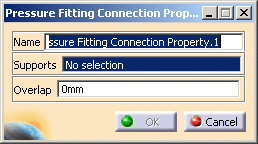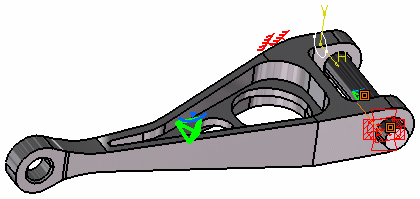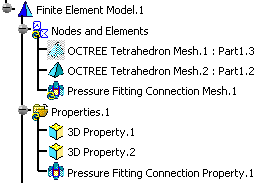This task shows how to create a Pressure Fitting Connection between two parts.
-
Only available with the Generative Assembly Structural Analysis (GAS) product
 .
. -
To have precisions and to know restrictions, refer to About Connection Properties.
-
The Gradient method is not available if several Pressure Fitting connections reference the same degree of freedom. In this case, try to choose another method type.
The pressure fitting connection uses assembly surface contact constraint as a support. A pressure fitting connection is the link between two bodies which are assembled in a Pressure Fitting configuration, more precisely when there are interferences or overlaps between both parts. Along the surface normal, the connection behaves as a contact connection with negative clearance value (positive overlap). The difference lies in the tangential directions where both parts are linked together. Since bodies can be meshed independently, the Pressure Fitting Connection is designed to handle incompatible meshes.
The Pressure Fitting Connection relations take into account the elastic deformability of the interfaces.
The program proceeds as follows:
-
each node of the finer surface mesh is projected parallel to the local outer normal of the first surface onto the second surface mesh.
-
a projection point is located whenever possible at the intercept of the projection direction with the second surface mesh (extrapolated at the face boundary by roughly half an element width).
-
if a projection point exists, the start node is connected by a a node-to-face element with contact property to all nodes of the element face on which the projection point has landed.
-
a set of join-type relations (involving interpolation using element shape functions) is computed between the degrees of freedom of the start node and the degrees of freedom of element face nodes (the projection point virtual degrees of freedom are eliminated in the process).
-
rigid body kinematical relations are computed between the start node and the nodes of element face.
-
these relations are rotated in a coordinate system the third vector of which corresponds to the normal of the local surface.
-
after the elimination of the projection point degrees of freedom, a pressure fitting relation is generated between the start node and the projected node, transforming the scalar equality relation into an inequality relation with a right-hand side equal to the minus user-defined overlap.
-
two scalar equality relations are generated in the tangential plane to link the tangential displacement of the start node and its projection.
Thus, the Pressure Fitting Connection generates at most as
many node-to-face elements with Pressure Fitting property as there are
nodes on the finer surface mesh for which a projection onto the opposite
surface mesh exists.
To know more about the generated element, refer to
Fitting Join in the Finite Element Reference Guide.
Open the sample16.CATAnalysis document from the samples directory: you applied constraints to the assembly (Assembly Design workbench).
-
Make sure you created a Finite Element Model containing a Static Analysis Case from this assembly.
-
Make sure you know all you need about what type of property you will use for what type of connection.
-
Click Pressure Fitting Connection Property
 in the Connection Properties toolbar.
in the Connection Properties toolbar.The Pressure Fitting Connection Property dialog box appears.

-
Name: lets you change the name of the connection property.
-
Support: lets you select the supports.
-
Overlap: lets you enter an algebraic value for the maximum allowed normal clearance reduction. The overlap indicates the interference between both parts. It is intended to be positive.
-
a positive Overlap value (used for instance to model a press-fitted clamp between the surfaces) means that the surfaces are already too close, and the program will have to push them apart.
-
a negative Overlap value (used to model a known gap between the surfaces) means that the surfaces can still come closer until they come in contact.
-
the default value used for the Overlap represents the actual geometric spacing between surfaces.
-
-
-
Select an assembly constraint previously created in the Assembly Design workbench.
The only allowed constraint type is Contact between body surfaces.
A symbol representing the Pressure Fitting Connection is visualized on the corresponding faces.

-
Optionally modify the default value of the overlap parameter. In this case, enter 0.001mm.
-
Click OK in the Pressure Fitting Connection Property dialog box.
Note that two elements appear in the specification tree:
-
A Pressure Fitting Connection Mesh.1 connection mesh part under the Nodes and Elements set
-
A Pressure Fitting Connection Property.1 connection property under the Properties.1 set.

-
![]()